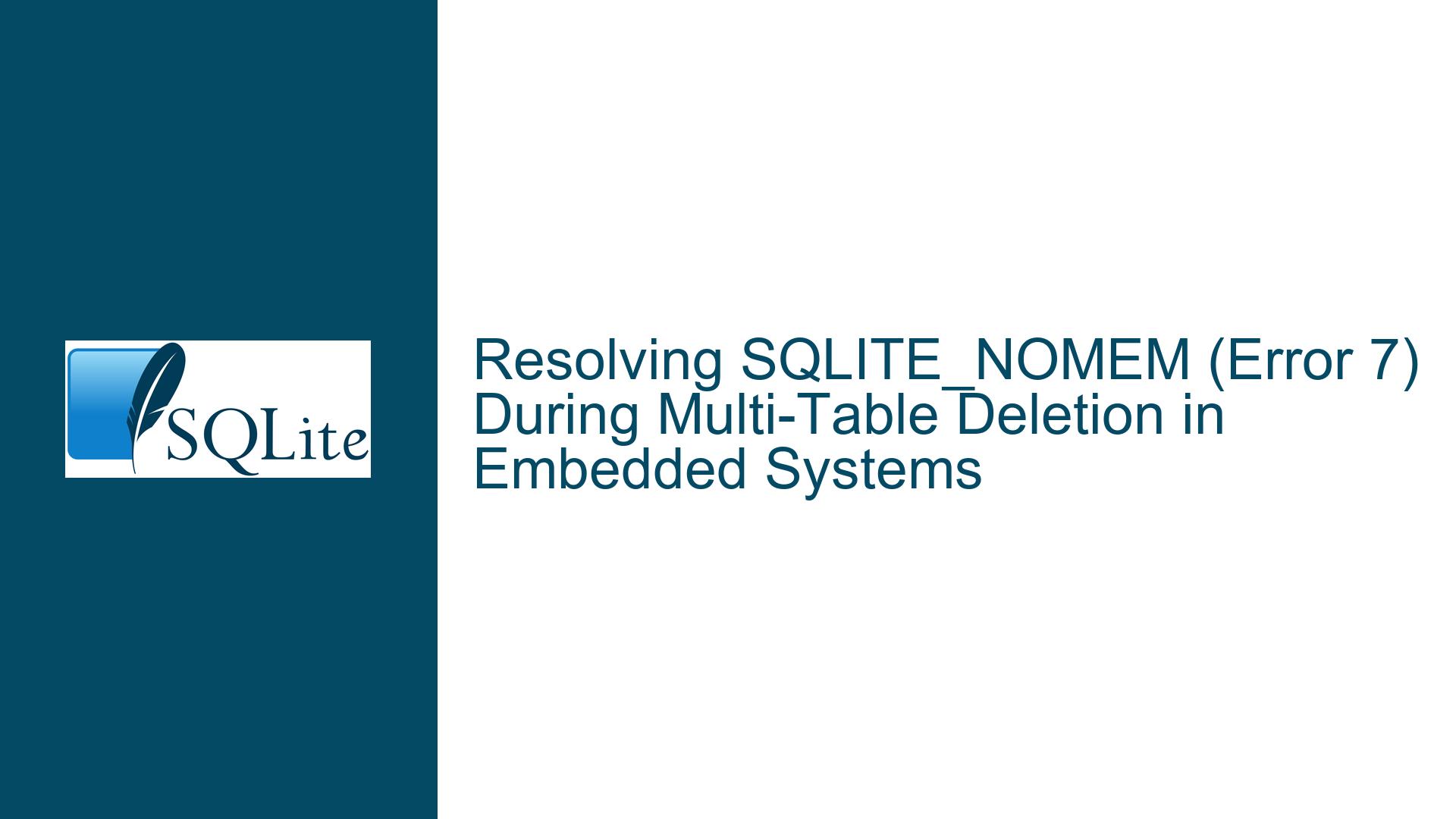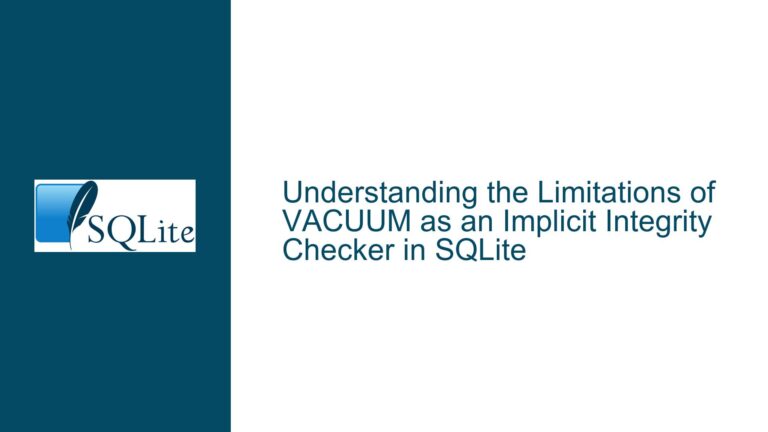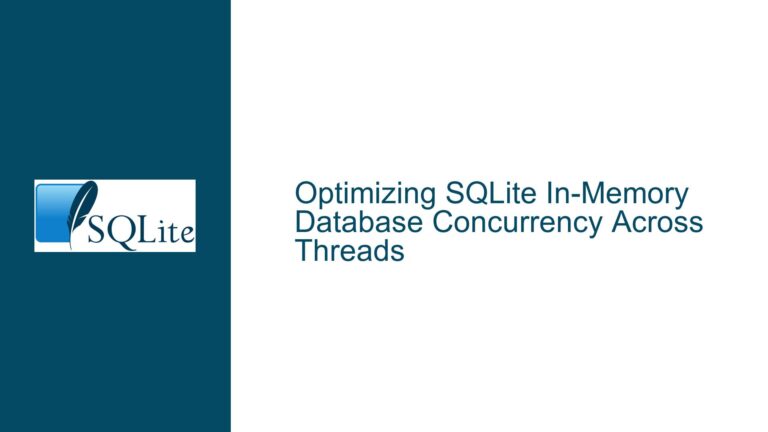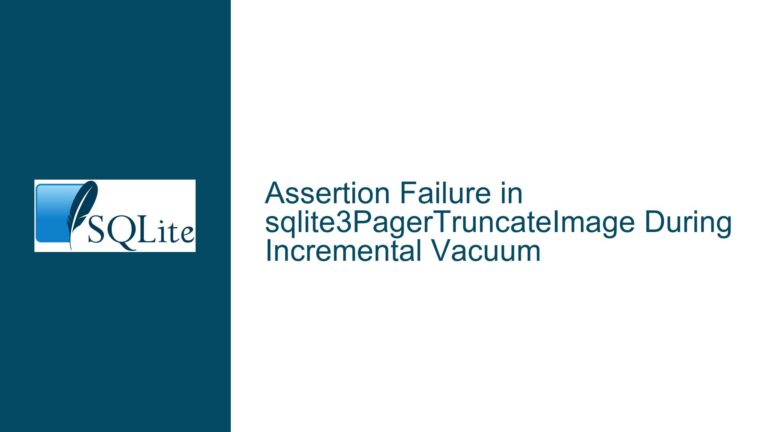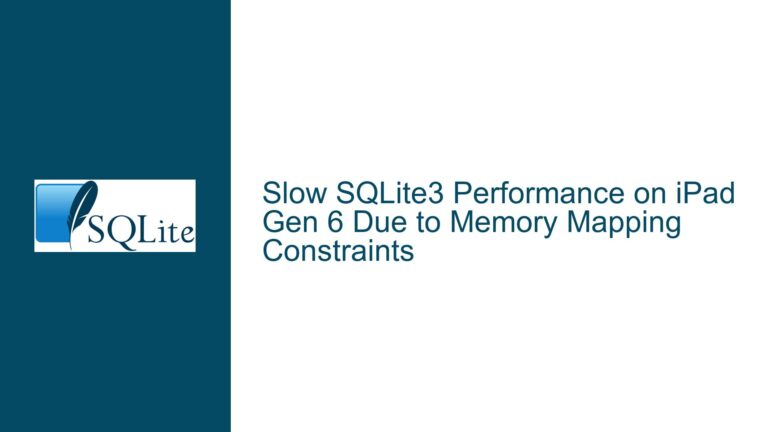Resolving SQLITE_NOMEM (Error 7) During Multi-Table Deletion in Embedded Systems
Embedded Device Database Corruption Due to SQLITE_NOMEM During Logout Sequence
Memory Exhaustion During Multi-Table Deletion Workflow
The core problem revolves around an embedded device encountering SQLITE_NOMEM (error code 7) during a logout procedure that deletes records from multiple tables in a SQLite database. The failure occurs consistently when processing the final table in the sequence, rendering the device inoperable in live environments. This error indicates that SQLite cannot allocate sufficient memory to complete the requested operation. The deletion logic involves 12+ tables with complex conditional DELETE statements targeting records older than a dynamically calculated date threshold. The workflow uses a cumulative error code (variable "Result") to proceed only if prior deletions succeeded. Critical observations include:
- Chained Deletion Logic: The code executes DELETEs sequentially across tables like TBLREPRINTTICKETTRANSACTIONS, tblTicketTransactions, tblTripInfo, and tblDeviceLoginHistory. Each DELETE operation depends on the success of prior steps (via "Result == 0" checks).
- Dynamic Query Construction: DELETE statements are built via string concatenation with parameters like
strDateBeforeExtensionDaysandstrWaybillNo, introducing risks of SQL injection and inefficient memory usage. - Subquery-Heavy Filters: Most DELETE operations include nested SELECT subqueries (e.g.,
SELECT distinct TRT.STRREPRINTTICKETNO...) that may generate large intermediate result sets. - Transaction Management Absence: No explicit transaction boundaries (BEGIN/COMMIT) are visible, forcing SQLite to use implicit transactions per statement, which increases memory overhead.
The error manifests specifically during the final table deletion because cumulative memory pressure peaks at this stage. Embedded systems often operate under strict memory constraints, and SQLite’s memory allocator may fail to secure additional memory after prolonged use in such environments.
Root Causes of Memory Allocation Failures in SQLite Operations
1. Memory Leaks in Application Code
The C++ code snippet reveals potential resource management issues:
- String Concatenation Overhead: Repeatedly constructing SQL queries via
deleteRecordsB4ExtDaysQueryForTicketDB = "DELETE ..."generates temporary string objects. If theDeleteUploadedRecordsBeforeExtensionDaysForTicketDBfunction does not properly release memory after each invocation, fragmentation or leaks occur. - Unreleased Prepared Statements: SQLite’s
sqlite3_prepare_v2()andsqlite3_step()require explicit deallocation viasqlite3_finalize(). If the application omits these calls, prepared statements accumulate in memory. - Connection Pooling Issues: Repeatedly opening/closing database connections without a pool can exhaust file descriptors or heap memory.
2. Inefficient Query Execution Plans
Complex subqueries in DELETE filters force SQLite to generate large temporary indexes or virtual machine bytecode. For example:
DELETE FROM tblDeviceLoginHistory WHERE ... INTDEVICELOGINID!=(SELECT MAX(...) FROM TBLDEVICELOGINHISTORY);
Executing the subquery for each row in the outer DELETE operation (a correlated subquery) results in O(n²) complexity, spiking memory usage. Missing indexes on columns like dteLoginDate or INTDEVICELOGINID exacerbate this.
3. SQLite Configuration Limits
Embedded builds of SQLite often customize memory thresholds via sqlite3_config(). Key limits include:
- SQLITE_CONFIG_HEAP: Defines the static memory pool. If too small, allocations fail during large operations.
- Page Cache Size: Set via
PRAGMA cache_size. Insufficient caching forces rereading pages from disk, increasing I/O and memory. - Temp Store Configuration:
PRAGMA temp_store=MEMORYforces temporary objects to RAM, which may overflow in low-memory conditions.
4. Fragmented Database Schema
The presence of LIMIT 500 clauses (e.g., DELETE FROM TBLINSPECTEDTICKETDETAIL ... LIMIT 500) suggests tables with millions of rows. Without VACUUM maintenance, tables become fragmented, requiring more memory to traverse.
Mitigating SQLITE_NOMEM via Query Optimization and Memory Profiling
Step 1: Identify Memory Leaks Using Embedded-Compatible Tools
- Valgrind Substitute for Embedded Targets: Cross-compile the application with
-pg -finstrument-functionsflags, then usegcovordmallocto profile memory usage on the host system. - SQLite Memory Hooks: Enable SQLite’s built-in memory tracking:
sqlite3_config(SQLITE_CONFIG_MEMSTATUS, 1); sqlite3_db_status(db, SQLITE_DBSTATUS_CACHE_USED, &curr, &highw, 0);Log
highwatervalues to detect leak trends.
Step 2: Optimize DELETE Queries for Minimal Memory Footprint
- Replace Subqueries with Joins: Convert correlated subqueries to JOINs in derived tables. Example rewrite:
DELETE FROM tblDeviceLoginHistory WHERE ... AND INTDEVICELOGINID NOT IN ( SELECT MAX(INTDEVICELOGINID) FROM TBLDEVICELOGINHISTORY GROUP BY dteLoginDate ); - Parameterize Queries: Use
sqlite3_bind_*()instead of string concatenation to reduce heap fragmentation:sqlite3_stmt *stmt; sqlite3_prepare_v2(db, "DELETE ... WHERE strWayBillNo = ?", -1, &stmt, 0); sqlite3_bind_text(stmt, 1, strWaybillNo, -1, SQLITE_STATIC); - Add Covering Indexes: Create indexes on WHERE/JOIN columns:
CREATE INDEX idx_tblDeviceLoginHistory_dteLoginDate ON tblDeviceLoginHistory(dteLoginDate) INCLUDE (bUploaded, bUploadedLogout);
Step 3: Implement Transaction Batching and Memory Caps
- Explicit Transactions: Wrap each DELETE group in a transaction to reduce overhead:
sqlite3_exec(db, "BEGIN;", 0, 0, 0); // Execute DELETE sqlite3_exec(db, "COMMIT;", 0, 0, 0); - Incremental Deletion with LIMIT: Process large tables in batches:
DELETE FROM TBLHHPROBLEM WHERE ... LIMIT 1000;Loop until
sqlite3_changes() == 0. - Adjust SQLite Memory Limits:
sqlite3_soft_heap_limit64(4 * 1024 * 1024); // 4MB cap sqlite3_db_config(db, SQLITE_DBCONFIG_LOOKASIDE, 2048, 512);
Step 4: Schema and Environment Hardening
- Rebuild Database File: Periodically execute
VACUUM;to defragment tables. - Disable Memory-Mapped I/O: Prevent mmap from competing for address space:
PRAGMA mmap_size = 0; - Upgrade SQLite: Ensure the device uses SQLite 3.37.0+ for improved memory reclamation.
Step 5: Error Handling and Recovery Tactics
- Retry with Exponential Backoff: On SQLITE_NOMEM, wait and retry:
int retries = 0; while ((rc = sqlite3_step(stmt)) == SQLITE_NOMEM && retries < 5) { usleep(1000 * (1 << retries)); retries++; } - Emergency Memory Release: Free non-critical caches before critical operations:
sqlite3_db_release_memory(db); sqlite3_release_memory(1024 * 1024);
By systematically addressing memory leaks, optimizing query execution plans, and configuring SQLite for embedded constraints, developers can eliminate SQLITE_NOMEM errors during multi-table deletions. Rigorous pre-deployment profiling using memory analysis tools is essential to prevent regression in resource-constrained environments.
